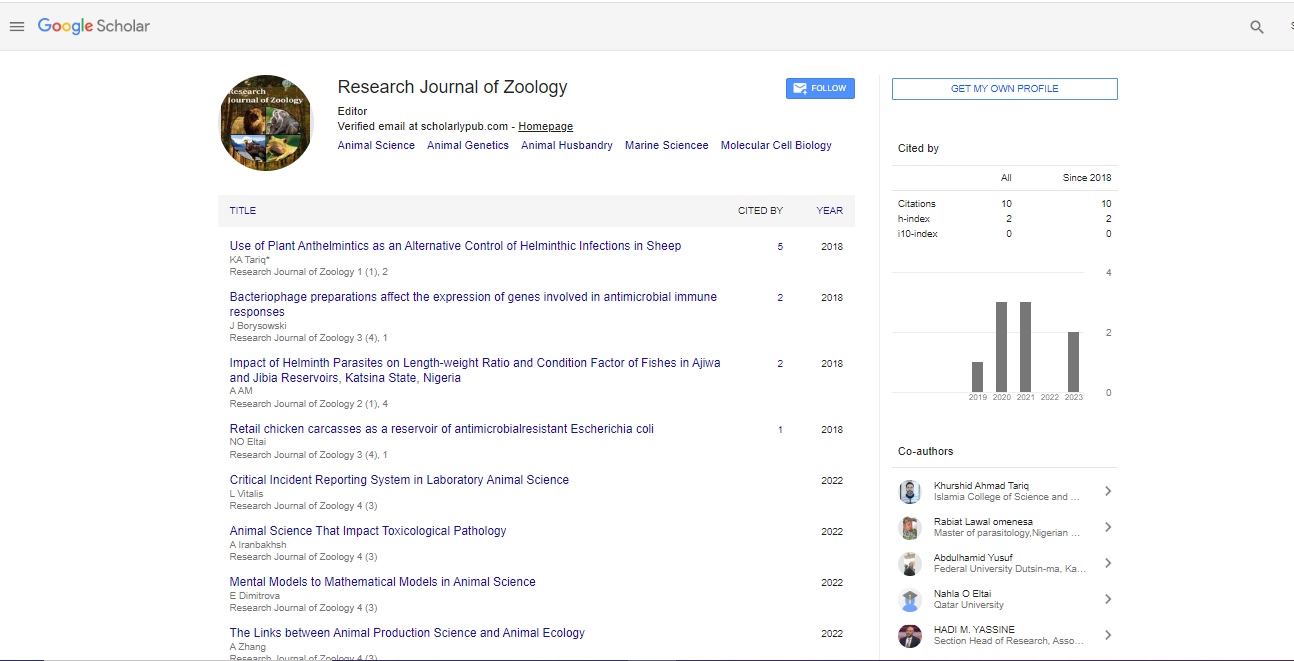Opinion Article, Res J Zool Vol: 4 Issue: 2
Imaging in Zoological Medicine Practice
Brown Kroesna*
Department of Genetic Medicine, Royal University, Cambodia
Corresponding Author: Brown Kroesna
Department of Genetic Medicine, Royal University, Cambodia
E-mail:BrownKroesna@ncsu.edu
Received date:01 March, 2022, Manuscript No. RJZ-22-62896;
Editor assigned date: 03 March, 2022, PreQC No. RJZ-22-62896(PQ);
Reviewed date: 17 March, 2022, QC No RJZ-22-62896;
Revised date: 21 March, 2022, Manuscript No. RJZ-22-62896(R);
Published date: 31 March, 2022, DOI: 10.4172/ RJZ.100065
Citation: Kroesna B (2021) Imaging in Zoological Medicine Practice. Res J Zool 4:2.
Keywords: Zoography, Comparative Anatomy, Animal Physiology, Behavioral Ecology. Ethology or Animal Behavior
Description
The destiny of plant rearinghas changed. Various sorts of atomic markers have been created and progressionin sequencing advancements has equipped yield improvement. To investigate theinformation about atomic markers, a few surveys have been distributed over themost recent thirty years; be that as it may, every one of these audits wereintended for analysts with cutting edge information on sub-atomic hereditaryqualities. This audit is expected to be a summary of on-going advancements inatomic markers and their applications in plant rearing and is committed toearly analysts with a practically no information on sub-atomic markers. Theadvancement made in sub-atomic plant rearing, hereditary qualities, genomicchoice and genome altering has added to a more complete comprehension ofsub-atomic markers and gave further bits of knowledge into the varietyaccessible for crops and incredibly supplemented reproducing tricks. Throughand through, the set of experiences, the kinds of markers, their application inplant sciences and rearing, and some new progression in genomic choice andgenome altering are talked about. Data about the hereditary varieties presentinside and between different plant populaces and their construction and levelcan assume a useful part in the proficient use of plants. To research thevariety and other significant qualities, various kinds of agronomic andmorphological boundaries have been utilized effectively. During the most recentthirty years, the world has seen a fast expansion in the information about theplant genome successions and the physiological and atomic job of differentplant qualities, which has upset the sub- atomic hereditary qualities and itsproductivity in plant reproducing programs.
Hereditary Markers
Hereditary markers aresignificant improvements in the field of plant rearing. The hereditary markeris a quality or DNA arrangement with a known chromosome area controlling aspecific quality or characteristic. Hereditary markers are firmly related withthe objective quality and they go about as sign or banners. Morphologicalmarkers can outwardly recognize characteristics like seed structure, blossomtone, development propensity and other significant agronomic qualities.Morphological markers are not difficult to use, with no necessity for explicitinstruments. They don't need any specific biochemical and atomic strategy.Reproducers have utilized such kind of markers effectively in the rearingprojects for different yields. Sequencing is a method where nucleotide basesand their request is distinguished along the DNA strand, and atomic markerswhich depend on the ID of a specific arrangement of DNA in a pool of obscureDNA are known as succession based markers. The improvement of this innovationcame about because of the way that hybridization-based markers are lessdependable and polymorphic. The advancement in the sequencing strategiesexpanded the interest for broad throughput sequencing with ease. This interestprompted the improvement of NGS and presently this strategy produces a greatmany successions. This strategy can create a few many millions to a few manybillions of DNA bases for every run. An introduction to zoological radiology,this article presents a brief overview of the variety of imaging modalities andsituations faced in the practice of the discipline. These are illustrated bybrief case summaries showing the diverse applications of imaging to diagnosisand treatment of wild animals. Markers and genome sequencing offer incrediblechance to research the hereditary variety in an extremely enormous germplasm.
Hereditary Variety
Hereditary variety evaluationis useful in the investigation of the advancement of plants and their neargenomics, assisting with understanding the construction of variouspopulaces.Hereditary markers have been effectively applied in the assurance ofhereditary variety and the grouping of hereditary material. DArT markers andSNPs markers are the most generally utilized markers for the assurance ofhereditary variety in different harvests. The most recent 30 years have seen aconstant advancement in the atomic markers innovation from RFLP to SNPs and avariety of exhibit innovation based markers. Progressions in the sequencingadvancements have prompted the improvement of NGS stages that are minimaleffort with high throughput. Disregarding the presence of these exceptionally progressed sub-atomic hereditary procedures, we are as yet not accomplishingour objectives. The principle explanation for this lies in erroneous phenotyping. High-throughput phenotyping strategies take care of these issuesby utilizing light, cameras, sensors, PCs and profoundly changed gadgets forthe assortment of exact phenotypic information, which is a center prerequisiteto accomplishing our rearing objectives effectively.
 Spanish
Spanish  Chinese
Chinese  Russian
Russian  German
German  French
French  Japanese
Japanese  Portuguese
Portuguese  Hindi
Hindi 
